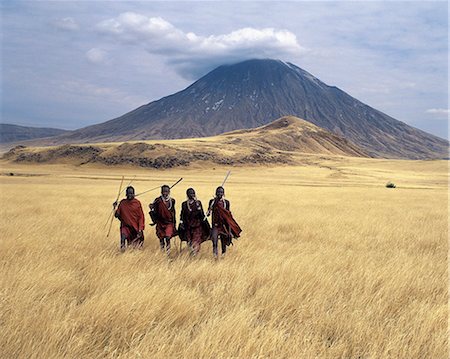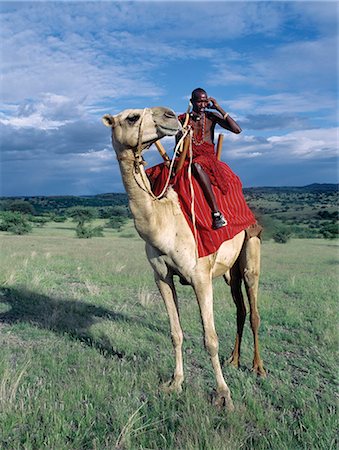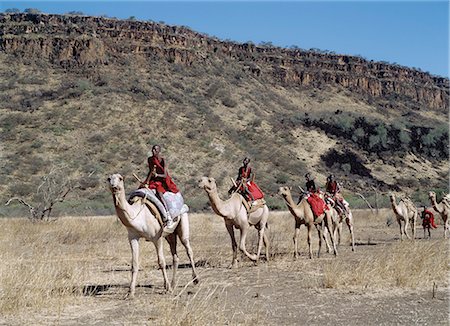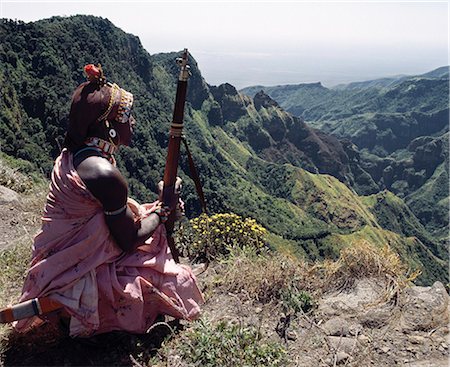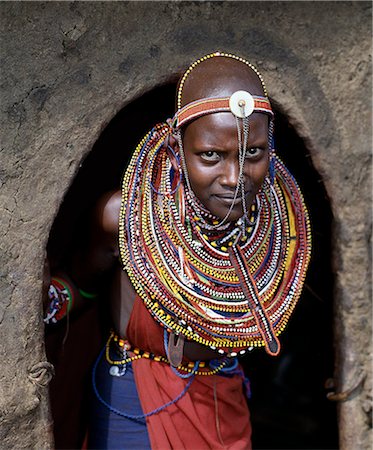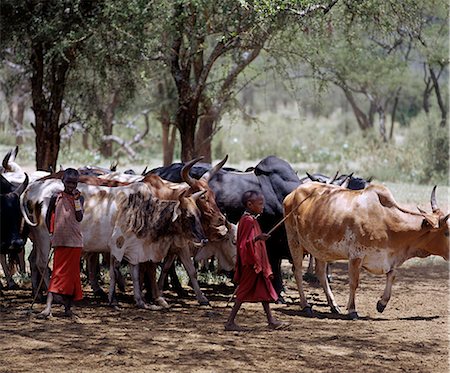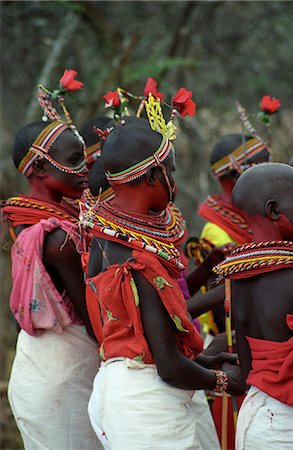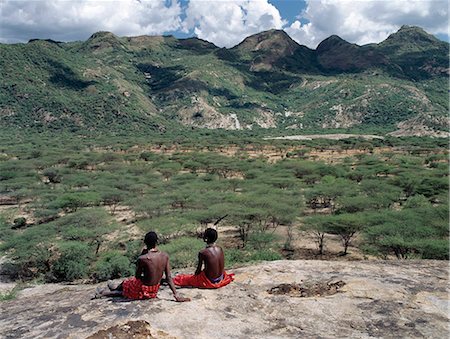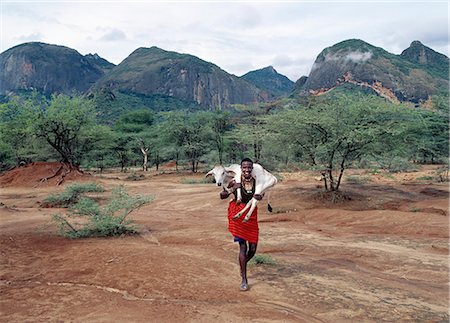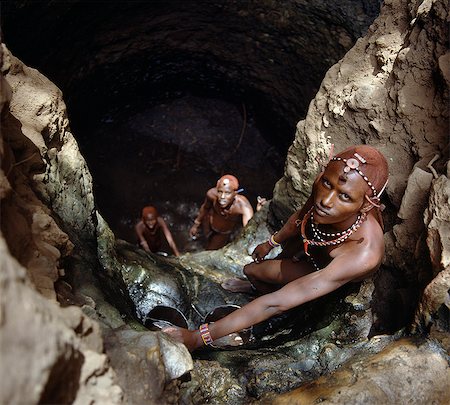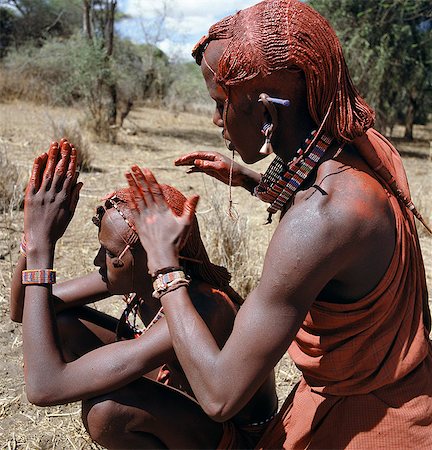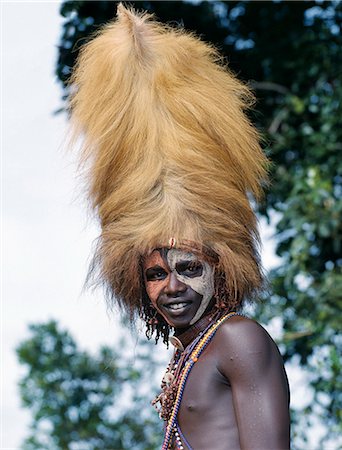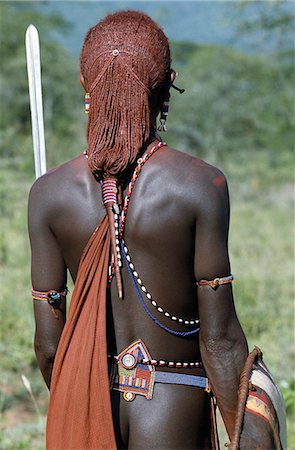-
Three Maasai girls sit on the edge of Shimu la Mungu (a volcanic blow hole known as 'God's hole') with the extinct volcano,Kerimasi,in the distance.
Rights-Managed
-
In the early morning,a Maasai family drives their livestock across the friable,dusty plains near Malambo in northern Tanzania.
Rights-Managed
-
In the early morning,a Maasai herdsboy and his sister drive their family's flock of sheep across the friable,dusty plains near Malambo in northern Tanzania.
Rights-Managed
-
Maasai herdsmen drive their cattle home in the late afternoon over the dusty volcanic soil at the base of the western wall of the Gregory Rift,which dominates the landscape in this remote corner of northern Tanzania.
Rights-Managed
-
A Colourful Maasai livestock market near the towering extinct volcano of Kerimasi.
Rights-Managed
-
A colourful Maasai livestock market near the towering extinct volcano of Kerimasi.
Rights-Managed
-
Maasai warriors stride across the golden grass plains at the foot of Ol doinyo Lengai, the Maasais Mountain of God. Ol doinyo Lengai is the only active volcano in the Gregory Rift, an important section of the eastern branch of Africas Great Rift Valley system that stretches from northern Kenya into Northern Tanzania.
Rights-Managed
-
Maasai men,spears in hand,drive their laden donkeys across pristine volcanic grassland at the southern end of Lake Natron. Donkeys carry loads in leather panniers strapped loosely to their flanks.
Rights-Managed
-
A Maasai man,spear in hand,drives his laden donkeys across pristine volcanic grassland at the southern end of Lake Natron. Donkeys carry loads in leather panniers strapped loosely to their flanks.
Rights-Managed
-
A young Maasai herdsboy controls his family's cattle at the Sanjan River to prevent too many animals watering at the same time.
Rights-Managed
-
A Maasai warrior and a young herdsboy draw water for livestock from the deep wells at Naberera where cattle paths are cut deep into the soil to allow livestock nearer to the source of water.
Rights-Managed
-
A young Maasai herdsboy drives his family's herds to grazing grounds close to the Sanjan River in Northern Tanzania.
Rights-Managed
-
Deep Maasai wells at Loibor Serrit where cattle paths are cut deep into the soil to allow livestock nearer to the source of water. Despite this immense amount of manual labour.Four fit, young men are necessary to bring water to the stock troughs about 30 feet above the water level at the bottom of the hand dug wells.
Rights-Managed
-
A Maasai warrior drives his family's cattle to the Sanjan River in northern Tanzania
Rights-Managed
-
Two Maasai warriors,spears on their shoulders,leave the friable dusty banks of the Sanjan River after watering their cattle.
Rights-Managed
-
Maasai livestock watering at the seasonal Sanjan River,which rises in the Gol Mountains of northern Tanzania.
Rights-Managed
-
Maasai livestock watering at the seasonal Sanjan River,which rises in the Gol Mountains of northern Tanzania.
Rights-Managed
-
The scene at a Maasai manyatta,or homestead,as the first rays of sun herald another scorching day in an arid part of northern Tanzania,south of Lake Natron.
Rights-Managed
-
Maasai pastoralists water their livestock at the seasonal Sanjan River,which rises in the Gol Mountains of northern Tanzania.
Rights-Managed
-
Maasai men,spears in hand,drive their laden donkeys across pristine volcanic grassland at the southern end of Lake Natron. Donkeys carry loads in leather panniers strapped loosely to their flanks
Rights-Managed
-
A warrior of the Kisongo section of the Maasai with his long Ochred braids decorated with beaded ornaments. His broad armulet is typical of the Kisongo living in northern Tanzania where white is the preferred colour of their beadwork.
Rights-Managed
-
Maasai warriors take enormous trouble over their appearance especially their long hair,which is braided,Ochred and decorated with beaded ornaments. This singular hairstyle sets them apart from the rest of their community.
Rights-Managed
-
A Maasai warrior speaks on his mobile phone from the saddle of his camel near Lake Magadi in Kenyas Rift Valley Province.Mobile phones are a popular method of communicating with family and friends in remote areas of Kenya.
Rights-Managed
-
Maasai men ride camels in the dry bush country at Olorgasailie,situated between Nairobi and Lake Magadi.
Rights-Managed
-
Maasai men ride camels in the dry bush country at Olorgasailie,situated between Nairobi and Lake Magadi.
Rights-Managed
-
Two Maasai men ride camels near Lake Magadi in Kenya's Rift Valley Province. Although the Maasai do not customarily keep camels,much of the semi-arid land of southern Maasailand is more suited to camels than cattle.
Rights-Managed
-
In the early morning,Maasai men lead a camel caravan laden with equipment for a 'fly camp' (a small temporary camp) along the shores of Lake Magadi.
Rights-Managed
-
Maasai men lead a camel caravan laden with equipment for a 'fly camp' (a small temporary camp) past Lake Magadi. Clouds hang low over the Nguruman Escarpment (a western wall of the Great Rift Valley) in the distance.
Rights-Managed
-
Maasai men lead a camel caravan laden with equipment for a 'fly camp' (a small temporary camp) close to Lake Magadi in beautiful late afternoon sunlight.
Rights-Managed
-
Maasai men lead a camel caravan laden with equipment for a 'fly camp' (a small temporary camp) close to Lake Magadi in beautiful late afternoon sunlight.
Rights-Managed
-
A Maasai woman wearing a very fine beaded necklace. The predominant white colour of her glass beadwork marks her as a Kisingo Maasai,the largest clan group of her tribe living either side of the Kenya-Tanzania border.
Rights-Managed
-
Maasai girls gather to celebrate a wedding. Their broad beaded necklaces with predominantly white glass beads mark then as Kisongo Maasai,the largest clan group of the tribe which lives either side of the Kenya-Tanzania border.
Rights-Managed
-
A Maasai girl in traditional attire. The predominant white colour of her beadwork and the circular scar on her cheek denote that she is from the Kisongo section of the Maasai,the largest clan group,which lives either side of the border in Kenya and Tanzania.
Rights-Managed
-
A Maasai warrior with his hair styled in a most unusual way. His long braids have been wrapped tightly in leather,decorated with beads and tied in an arch over his head. A colobus monkey tail sets this singular hairstyle apart from the more traditional warrior styles.
Rights-Managed
-
A Maasai woman in traditional attire. The preponderance of white glass beads in her ornaments denotes that she is from the Kisongo section of the Maasai,the largest clan group,which lives on both sides of the Kenya-Tanzania border.
Rights-Managed
-
Datoga herdsmen drive their family's cattle along the edge of Lake Balangida Lelu,a seasonal alkaline lake situated due south of Lake Eyasi in northern Tanzania. Balang'ida in the Datoga language means 'salt'.The Datoga (known to their Maasai neighbours as the Mang'ati and to the Iraqw as Babaraig) live in northern Tanzania and are primarily pastoralists.
Rights-Managed
-
Two young Datoga men work wells on the east side of Lake Manyara to water their family's livestock. The man who draws water balances precariously on two poles.The Datoga (known to their Maasai neighbours as the Mang'ati and to the Iraqw as Babaraig) live in northern Tanzania and are primarily pastoralists.
Rights-Managed
-
A young Maasai girl wears a headband decorated with chains and cowrie shells that signifies her recent circumcision. Clitodectomy was commonly practiced by the Maasai but it is now gradually dying out.
Rights-Managed
-
A Samburu homeguard looks out over the steep-sided gorge of Mount Kulal,which divides the mountain into two. Volcanic in origin,Mount Kulal rises to over 6,000 feet in Northern Kenya and is surrounded by a sea of lava and arid wastes. The mountain is forested on top and is a vital water resource. It's open grasslands give pastoralists good grazing for their livestock.
Rights-Managed
-
A young Maasai girl keeps the holes in her pierced ears from closing with grass and rolled leaves. She will gradually stretch her earlobes by inserting progressively larger wooden plugs. By tradition,both Maasai men and women pierce and elongate their earlobes for decorative purposes.
Rights-Managed
-
A young Maasai girl wearing a wooden plug in her pierced ear to elongate the earlobe. It has been a tradition of the Maasai for both men and women to pierce their ears and elongate their lobes for decorative purposes. Her two lower incisors have been removed - a common practice that may have resulted from an outbreak of lockjaw a long time ago.
Rights-Managed
-
Young Maasai girls decorate their faces with ochre and clay in preparation for a dance.
Rights-Managed
-
A young Maasai girl in all her finery pauses at the entrance to her mother's home. The wall and roof of the house are plastered with a mixture of cow dung and soil.
Rights-Managed
-
Maasai girls in all their finery and with bells tied round their legs wait at the entrance to a house before dancing with warriors.
Rights-Managed
-
A young Maasai girl wears face paint and numerous beaded ornaments in preparation for a dance with warriors.
Rights-Managed
-
Two young Maasai girls help to herd their family's cattle near a waterhole in the foothills of Ol doinyo Orok (the Black Mountain). Childhood is very short in Maasailand; children begin to help their parents at a young age and may never attend school.
Rights-Managed
-
A Turkana man drives his donkeys through lava fields as clouds gather above Mount Nyiru.
Rights-Managed
-
A Hadza hunter sits on a rock close to Lake Eyasi with Mount Oldeani rising in the distance.The Hadzabe are a thousand strong community of hunter gatherers who have lived in the Lake Eyasi basin for centuries.
Rights-Managed
-
A Maasai boy herds his family's cattle near a waterhole in the foothills of Ol doinyo Orok (the Black Mountain). Childhood is very short in Maasailand; children begin to help their parents at a young age and may never attend school.
Rights-Managed
-
In the late afternoon,a Maasai boy drives his father's cattle home across the grassy plains west of the Lake Manyara National Park.
Rights-Managed
-
In the late afternoon,a Maasai boy drives his father's cattle home across the grassy plains west of the Lake Manyara National Park.
Rights-Managed
-
A Wa-Arusha warrior carries home a yoke. His brown necklace is made from aromatic wood. The Wa-Arusha are closely related to the Maasai and speak the same maa language. Unlike the Maasai,however,they till the land. In the past,this has brought them into conflict with their pastoral neighbors who disdained cultivation.
Rights-Managed
-
A Maasai elder in traditional attire. Red has always been the preferred Maasai colour. Bell-shaped brass earrings are typically worn by the elders of the tribe.
Rights-Managed
-
Old and new. Dressed traditionally and carrying familiar wooden staff,two young men give hints that the lifestyle of younger Maasai generations is changing gradually in Tanzania.
Rights-Managed
-
A young boy of the Datoga tribe crosses the plains east of Lake Manyara in Northern Tanzania. The Manyara escarpment (a western boundary wall of the Gregory Rift) is visible in the distance. The Datoga (known to their Maasai neighbours as the Mang'ati and to the Iraqw as Babaraig) live in northern Tanzania and are primarily pastoralists..
Rights-Managed
-
Detail of a Maasai warrior's ear ornaments and other beaded or metal adornments. The Maasai practice of piercing ears in adolescence and gradually elongating the lobes is gradually dying out. This warrior's body and his long braids have been smeared with red ochre mixed with animal fat.
Rights-Managed
-
Two Samburu warriors relax on a rock outcrop near the foothills of the Ndoto Mountains in Samburuland. This northern region of semi-arid thorn scrub country barely supports sufficient livestock for the semi-nomadic pastoralists living there.The Samburu of Northern Kenya are related to their more famous cousins,the maa speaking Maasai.
Rights-Managed
-
A Samburu warrior carries home a small calf to his family's manyatta (homestead) situated in the foothills of the rugged Ndoto Mountains. The Samburu of Northern Kenya are a semi-nomadic pastoral community related to their more famous cousins,the maa speaking Maasai.
Rights-Managed
-
A large gathering of Maasai warriors,resplendent with long Ochred braids,listen to instructions from their chiefs and elders during a ceremony
Rights-Managed
-
A group of Maasai warriors,resplendent with long Ochred braids,chat outside their traditional houses. These squat houses with rounded corners have roofs plastered with a mixture of soil and cow dung,so need regular repairs during rain.
Rights-Managed
-
Ole Senteu Simel,grandson of the famous Maasai Laibon Mbatian (after which the highest peak of Mount Kenya is named),was the most respected laibon of the Maasai until his death in 1986. This photograph was taken three weeks before he died. Maasai Laibons are the soothsayers and clairvoyants of the tribe and control all ceremonial occasions.
Rights-Managed
-
Maasai warriors draw water from a deep well. The depth of wells is measured by the number of men required to bring water to the cattle troughs at the top of them. A three-man well will be about 24 feet deep since the buckets are thrown between the men in a rhythmic chant.
Rights-Managed
-
A Maasai elder herds his cattle near the foothills of Ol doinyo Orok (the Black Mountain).
Rights-Managed
-
A Maasai warrior resplendent with his long ochred braids tied in a pigtail watches over his family's cattle,spear in hand. The singular hairstyle of warriors sets them apart from other members of their society.
Rights-Managed
-
During their dances,Maasai warriors take turns to leap high in the air from a standing position without bending their knees. They achieve this by flexing their ankles in a seemingly effortless way .
Rights-Managed
-
A Maasai warrior blows a trumpet fashioned from the horn of a Greater Kudu. The strap is decorated with cowrie shells. Kudu-horn trumpets are only sounded to call men to arms or on ceremonial occasions.
Rights-Managed
-
A Maasai warrior resplendent with long ochred braids tied in a pigtail at the back,puts red ochre on his friend's plaits. Red ochre is anatural earth,which is mixed with animal fat to the consistency of greasepaint.
Rights-Managed
-
Kenya,Trans-Mara,Lolgorien. The Maasai do not eat game meat or birds. Consequently,the wildlife in their vast grazing areas has been left relatively undisturbed. The warriors do hunt lions,however,when their cattle are killed. The warrior who spears a lion to death will make a busby-style headdress from its mane.
Rights-Managed
-
A back view of a Maasai warrior resplendent with long ochred braids tied in a pigtail. This singular hairstyle sets him apart from other members of his society. His beaded belt is of a style only worn by warriors. The little copper bell-shaped ear ornament hanging from his elongated and decorated earlobe is also peculiar to the Maasai.
Rights-Managed
-
A Maasai warrior with his long braids and body coated with red ochre mixed with animal fat. He has put ochre dust round his eyes to enhance his appearance ready for a dance. The singular hairstyles of Maasai warriors sets them apart from other members of their society.
Rights-Managed
-
A Maasai warrior has daubed himself with red ochre mixed with animal fat to participate in a dance. His long ochred braids have been drawn forward from the crown of the head and tied in three places. This singular hairstyle sets warriors apart from the rest of their society.
Rights-Managed
-
A Maasai warrior resplendent with long ochred braids. His body has been smeared with red ochre mixed with animal fat while parts of his face have been covered with ochre powder.
Rights-Managed
-
Kenya,Kajiado,Maparasha. A Maasai warrior resplendent with long,ochred braids. This singular form of hairstyle distinguishes warriors from the rest of their society. This man has looped his elongated and decorated earlobes over his ears - a common practice when walking through thorn scrub country to prevent the loops being snagged by thorns.
Rights-Managed
-
A Maasai warrior in full regalia. He has stuck a porcupine quill in his beaded headband to add to his other decorations. His long,Ochred plaits have been drawn forward from the crown of his head and tied in three bunches.
Rights-Managed
-
Kenya,Kajiado,lpartimaro. Two Maasai warriors in full regalia. The headress of the man on the left is made from the mane of a lion while the one on the right is fringed with black ostrich feathers. Their traditional weaponry includes long-bladed spears and shields are made of buffalo hide.
Rights-Managed
-
One of the most important Maasai ceremonies is the eunoto when warriors become junior elders. Early one morning before the cattle are taken to pasture,their mothers shave their long ochred locks,which makes their appearance very different. One initiate can be seen blowing a Kudu horn trumpet.
Rights-Managed
-
During an eunoto ceremony when Maasai warriors become junior elders,their heads are shaved and they daub themselves with white clay.
Rights-Managed
-
Maasai warriors resplendent with long ochred braids relax and wait for the start of a ceremony. Red has always been their preferred colour.
Rights-Managed
-
The numerous decorated iron bracelets worn by a Datoga woman. During song and dance,she will rub them together to keep rhythm. Her traditional attire includes a beautifully tanned leather dress embellished with beads. The Datoga (known to their Maasai neighbours as the Mang'ati and to the Iraqw as Babaraig) live in northern Tanzania and are primarily pastoralists.
Rights-Managed






